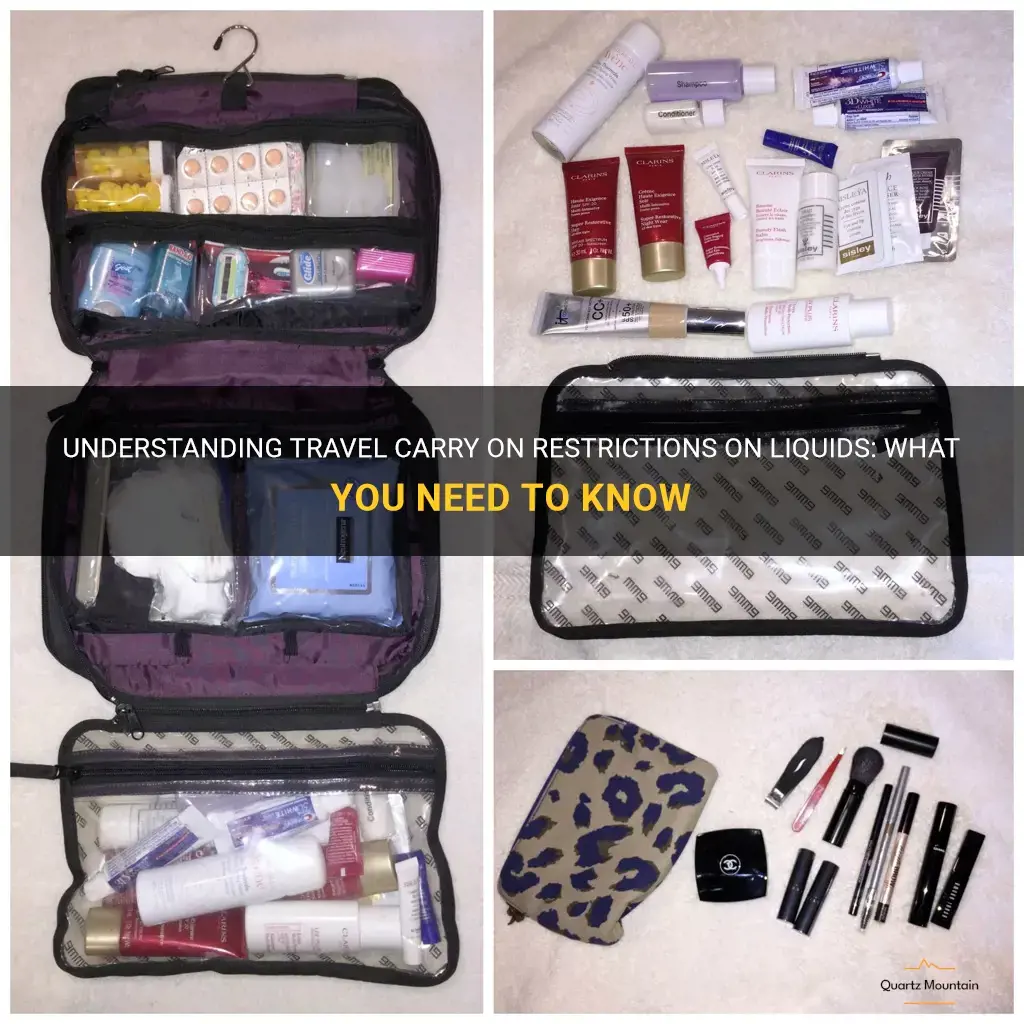
Traveling can be an exciting experience, but navigating through the various carry-on restrictions can be a headache. One of the most confusing restrictions is the limitation on carrying liquids. From shampoo to toothpaste, we are all familiar with having to pack our toiletries in small containers and fit them into a clear plastic bag. These restrictions may seem frustrating, but they are in place for a reason. In this article, we will explore the reasons behind travel carry-on restrictions on liquids and how to navigate this restriction without sacrificing your essential toiletries. So, sit back, relax, and let's dive into the world of travel carry-on restrictions on liquids.
| Characteristic | Value |
|---|---|
| Container size | 3.4 ounces or less |
| Container quantity | 1 quart-sized clear bag |
| Bag size | 1 bag per passenger |
| Bag type | Clear, plastic, quart-sized |
| Exceptions | Medications, baby formula |
What You'll Learn
- What are the current travel carry on restrictions for liquids?
- How much liquid can I bring in my carry on bag?
- Are there any exceptions to the liquid restrictions for medical or baby products?
- Can I carry an empty water bottle through airport security?
- What are the consequences if I accidentally bring a prohibited liquid in my carry on bag?

What are the current travel carry on restrictions for liquids?
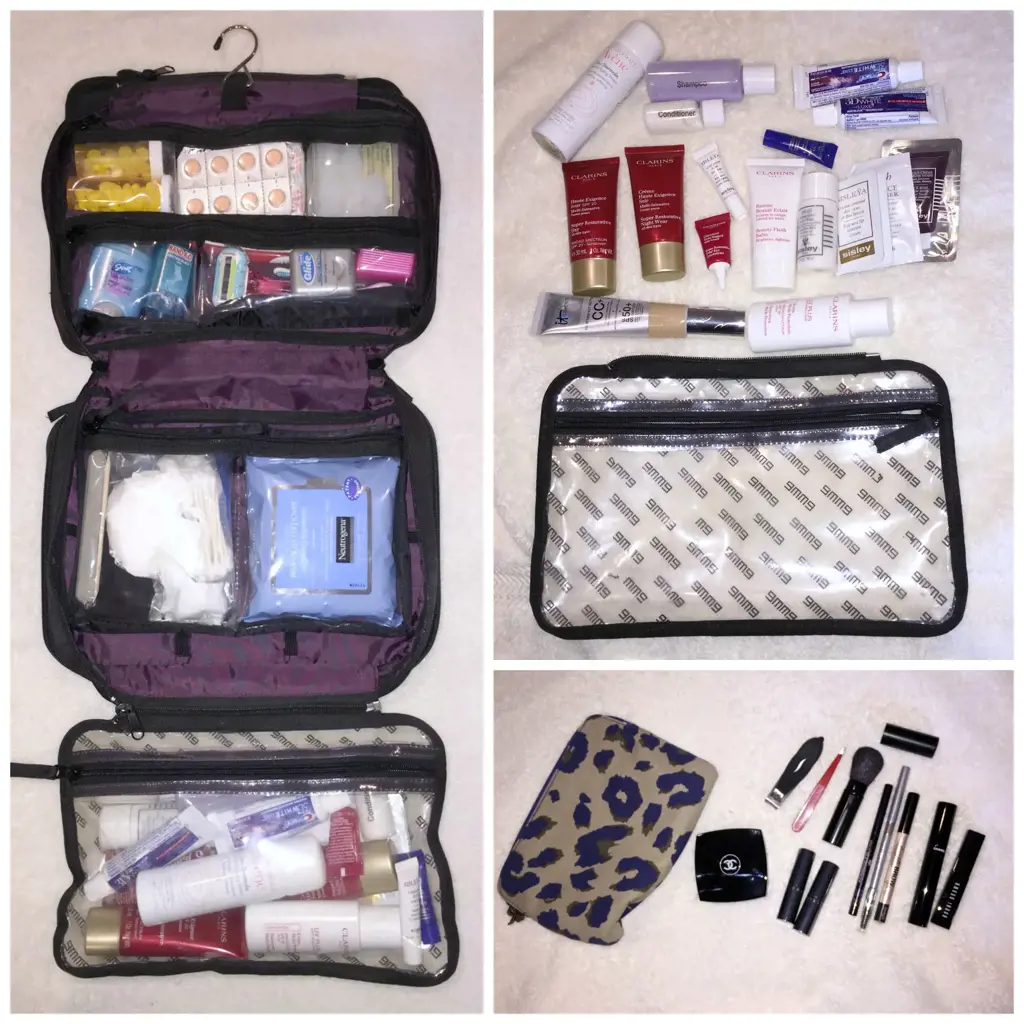
In recent years, there have been a number of travel carry on restrictions when it comes to bringing liquids on board airplanes. These restrictions were put in place in order to enhance security measures and ensure the safety of all passengers on board. Understanding and adhering to these restrictions is crucial for a hassle-free travel experience.
As of 2021, the current travel carry on restrictions for liquids are primarily governed by the Transportation Security Administration (TSA) in the United States. However, similar rules apply to most international airports as well. The main restriction is known as the 3-1-1 rule.
The 3-1-1 rule states that passengers are allowed to bring liquids in their carry on luggage in containers that are no larger than 3.4 ounces (100 milliliters) each. These containers must all fit into a single, clear, quart-sized plastic bag. Each passenger is allowed only one such bag, which must be placed separately in a security bin for screening.
It is important to note that the 3-1-1 rule applies to all types of liquids, including gels, pastes, creams, aerosols, and other similar substances. This includes common items such as shampoo, toothpaste, lotion, and even beverages like water or soda. It is also worth noting that this rule applies to both checked luggage and carry on luggage, so it is important to plan accordingly when packing.
To adhere to the 3-1-1 rule, it is advisable to transfer any larger containers of liquids into smaller travel-sized bottles. These can be easily found at most drugstores or convenience stores. Additionally, it is important to ensure that all bottles are tightly sealed to prevent any leaks or spills during the flight. Labeling each bottle can also help avoid any confusion during the security screening process.
In certain circumstances, there may be exceptions to the 3-1-1 rule. For example, if you require specific medications, baby formula, or breast milk, you are allowed to bring these in larger quantities. However, it is advisable to notify the security officers in advance and be prepared to provide proper documentation or proof of necessity.
Failure to comply with the travel carry on restrictions for liquids can lead to delays at the security checkpoint, confiscation of prohibited items, or even denial of boarding. It is therefore essential to familiarize yourself with these rules before embarking on your journey to ensure a smooth and stress-free travel experience.
In conclusion, the current travel carry on restrictions for liquids include the 3-1-1 rule, which limits passengers to containers of 3.4 ounces or less. Adhering to this rule and properly packing liquids in a clear, quart-sized plastic bag will help ensure a smooth screening process at airport security checkpoints. It is important to note any exceptions to the rule, such as medications or baby-related items, and be prepared to provide necessary documentation when necessary. By following these guidelines, travelers can navigate the restrictions and enjoy a safe and enjoyable journey.
Understanding the Current Travel Restrictions to Peru
You may want to see also

How much liquid can I bring in my carry on bag?
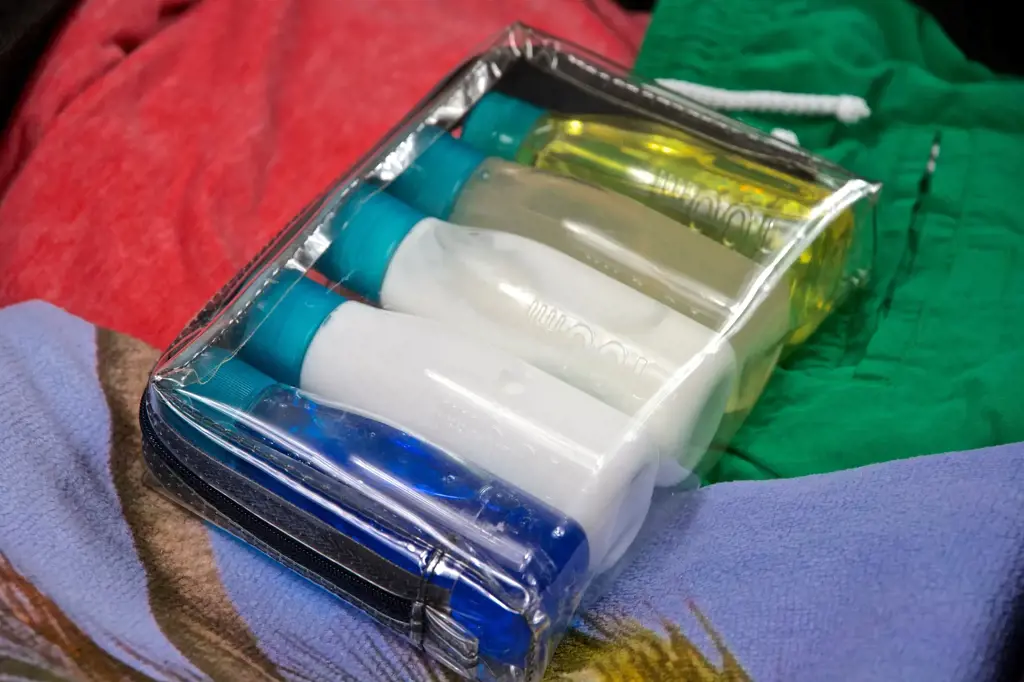
If you're planning to bring liquids in your carry-on bag, it's important to know the rules and restrictions in place for air travel. The Transportation Security Administration (TSA) has guidelines in place to ensure the safety of all passengers. Here is some information on how much liquid you can bring in your carry-on bag.
The TSA's 3-1-1 Rule
The TSA's 3-1-1 rule applies to liquids, gels, aerosols, creams, and pastes. This rule states that you can bring containers that are 3.4 ounces (100 milliliters) or less in your carry-on bag. These containers must all fit into a single, clear, quart-sized plastic bag. Each passenger is allowed one bag per screening.
This means that you can bring multiple small containers of liquids, as long as they are each 3.4 ounces or smaller and fit into the designated clear plastic bag. It's important to note that the size of the container is what matters, not the amount of liquid inside. Even if you have a small amount of liquid in a larger container, it will still need to be within the size restrictions.
Examples of Liquids
When it comes to liquids, it's important to understand what is considered a liquid. Common examples include water, soda, juice, perfume, shampoo, lotion, toothpaste, and gel. If you're unsure if an item counts as a liquid, it's best to check with the TSA before packing it in your carry-on bag.
Additional Considerations
While the 3-1-1 rule is a general guideline, there are a few exceptions and additional considerations to keep in mind:
- Medications: Prescription and over-the-counter medications are allowed in larger quantities than 3.4 ounces. However, they should be properly labeled and declared to the TSA at the security checkpoint.
- Baby formula and food: If you're traveling with a baby or young children, you can bring reasonable quantities of baby formula, breast milk, or juice in your carry-on bag. These items may be subject to additional screening.
- Liquid-filled containers: If you're bringing a liquid-filled container that is larger than 3.4 ounces, such as a water bottle, it must be completely empty when going through the security checkpoint. Once you've passed through security, you can fill the container at a water fountain or purchase beverages in the airport.
When packing liquids in your carry-on bag, it's important to follow the TSA's 3-1-1 rule. This means bringing containers that are 3.4 ounces or less and packing them in a single, clear, quart-sized plastic bag. Knowing these rules and restrictions will help ensure a smooth and hassle-free journey through airport security.
Exploring the Impact of Colorado's Ski Travel Restrictions: What You Need to Know
You may want to see also

Are there any exceptions to the liquid restrictions for medical or baby products?
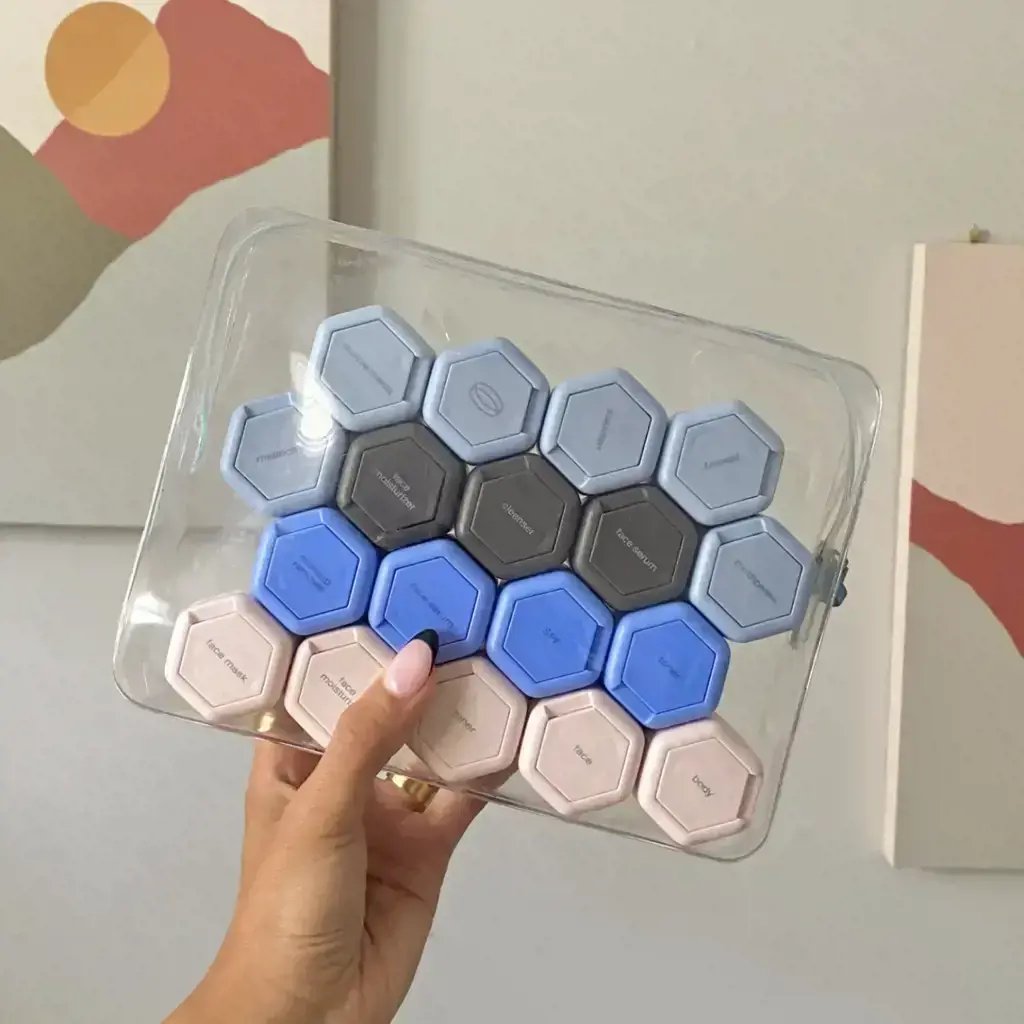
When it comes to traveling, the Transportation Security Administration (TSA) has strict rules regarding liquids in carry-on luggage. These limitations are in place to ensure the safety and security of air travel. However, there are some exceptions to these liquid restrictions for medical or baby products.
Medical liquid exceptions:
If you are carrying medically necessary liquids, such as prescription medications, over-the-counter medicines, or medical supplies, you are allowed to bring them in your carry-on baggage. These items are not subject to the usual 3-1-1 liquids rule, which states that liquids must be in containers no larger than 3.4 ounces (100 milliliters) and placed in a clear, quart-sized bag.
To bring medical liquids through security, you will need to inform the TSA officer before the screening process. You may be asked to present these items separately for inspection. It's a good idea to have your medications properly labeled and bring a copy of your prescription, if applicable, to avoid any issues.
Baby product exceptions:
Parents traveling with young children are also allowed certain exceptions to the liquid restrictions. Baby formula, breast milk, and juice for infants or toddlers are exempt from the 3-1-1 rule. These items can be packed in quantities that exceed 3.4 ounces (100 milliliters). However, you will have to remove these items from your carry-on bag and place them in a separate bin for screening.
The TSA recommends packing these liquids in a clear, quart-sized bag to help expedite the screening process. They may also choose to inspect these items further, so it's important to allow for extra time during security checks.
It's worth noting that these exceptions only apply to liquids that are directly related to medical or baby care. Other liquid items, such as drinks or toiletries, must still adhere to the standard liquid restrictions.
In conclusion, there are exceptions to the liquid restrictions for medical or baby products when traveling by air. Medical liquids, including prescription medications and medical supplies, are allowed in larger quantities and do not have to fit within the 3-1-1 rule. Similarly, parents can bring baby formula, breast milk, and juice for infants or toddlers in quantities exceeding 3.4 ounces. However, it's important to inform the TSA officer and be prepared to present these items separately for inspection.
Exploring the Likelihood of America Changing Travel Restrictions
You may want to see also

Can I carry an empty water bottle through airport security?
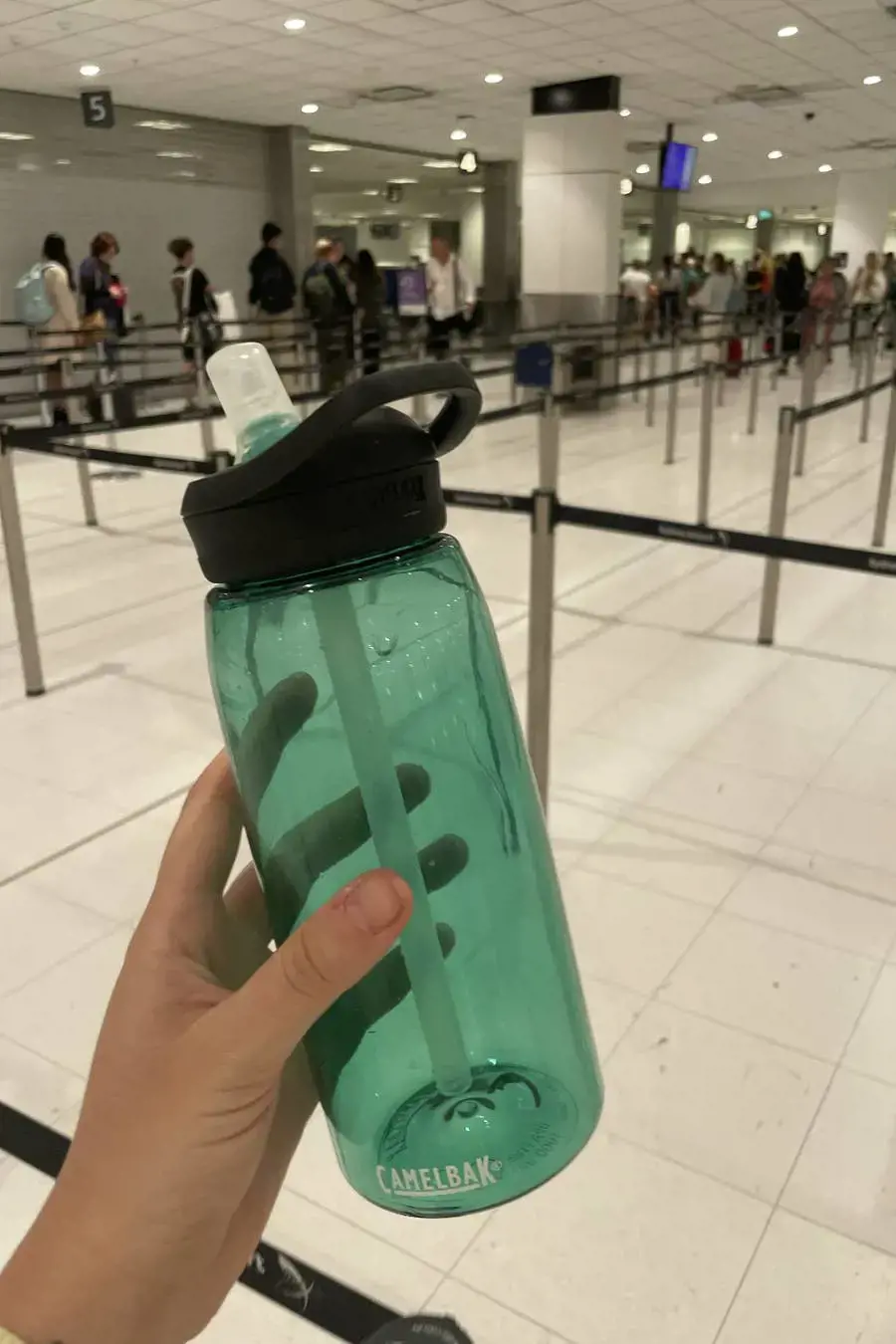
If you're a frequent flyer, you might have wondered whether you can carry an empty water bottle through airport security. After all, staying hydrated is important during your travels, and having a refillable water bottle can help you save money and reduce waste. So, what's the deal with empty water bottles and airport security? Let's find out.
The short answer is yes, you can carry an empty water bottle through airport security. The Transportation Security Administration (TSA) allows passengers to bring empty containers through the security checkpoint. However, there are some important considerations to keep in mind.
First, make sure the water bottle is truly empty. Any liquids, including water, in containers that are larger than 3.4 ounces (100 milliliters) are not allowed through security. This rule is in place to prevent the threat of liquid explosives. So, if you have a larger container, make sure to empty it before heading to the airport. It's also a good idea to remove any labels or stickers from the bottle to avoid confusion or delays.
Next, be prepared to have your empty water bottle screened separately by the TSA. Your empty bottle will go through the x-ray machine just like your other belongings. The TSA officer may also conduct a visual inspection of the bottle. This additional screening step is necessary to ensure that the bottle doesn't contain any prohibited items or substances.
It's worth noting that while you can bring an empty water bottle through security, you won't be able to refill it until you're past the checkpoint. Typically, airports have water fountains or bottle filling stations located in the gate areas, so you can fill up your empty bottle before boarding your flight. However, it's a good idea to check the specific amenities at your departure airport, as some airports may have limited access to water sources.
Carrying an empty water bottle through airport security is not only convenient for staying hydrated, but it's also an environmentally-friendly choice. By bringing your own refillable bottle, you can reduce the amount of plastic waste generated by single-use disposable water bottles. Plus, having your own bottle allows you to choose your preferred drinking vessel, whether it's a stainless steel, glass, or BPA-free plastic container.
In conclusion, yes, you can carry an empty water bottle through airport security. Just make sure it's truly empty, be prepared for additional screening, and remember that you won't be able to fill it up until you're past the security checkpoint. So, next time you're preparing for a trip, don't forget to pack your empty water bottle and stay hydrated on the go!
Exploring the Latest Phuket Travel Restrictions: What You Need to Know
You may want to see also

What are the consequences if I accidentally bring a prohibited liquid in my carry on bag?
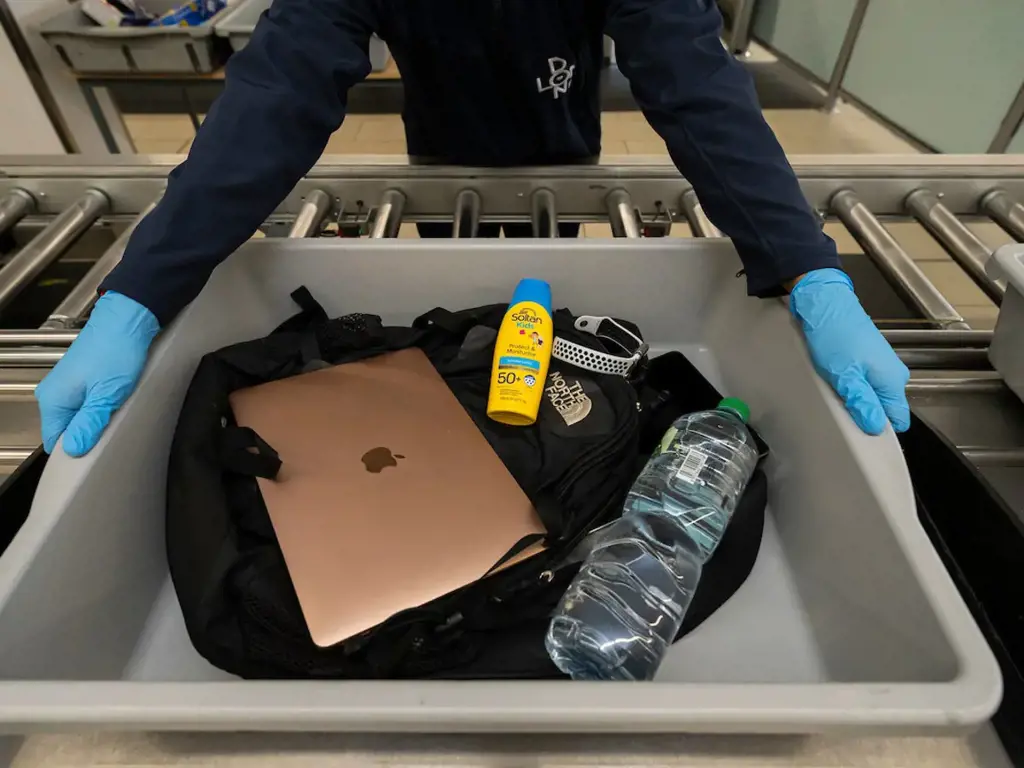
Accidentally bringing a prohibited liquid in your carry-on bag can have several consequences, ranging from inconvenience to potential legal issues. It is important to be aware of the rules and regulations regarding liquids in carry-on bags to avoid any unexpected consequences. This article will outline some of the potential consequences and provide advice on how to avoid them.
When traveling by air, most countries have restrictions on the amount and type of liquids that can be brought in carry-on bags. These regulations are primarily in place for security reasons, as liquids can potentially be used to create explosive devices or other dangerous substances.
If you accidentally bring a prohibited liquid in your carry-on bag, the most common consequence is that it will be confiscated by airport security during the screening process. This can be a minor inconvenience if the liquid is easily replaceable, such as a bottle of water or a small toiletry item. However, if the liquid is valuable or not easily replaced, it can be frustrating to lose it.
In some cases, bringing a prohibited liquid in your carry-on bag can result in more serious consequences. Airport security may detain you for further questioning if they suspect that you are intentionally trying to bring a prohibited item on board. This can lead to delays and potential missed flights. In extreme cases, you may even face legal consequences if it is determined that you intentionally brought a dangerous substance on board.
To avoid these consequences, it is important to familiarize yourself with the rules and regulations of the airport or country you are traveling through. Most airports adhere to the 3-1-1 rule, which states that liquids must be in containers that are 3.4 ounces (100 milliliters) or smaller, all containers must fit in a single quart-sized bag, and each passenger is limited to one quart-sized bag.
To make the security screening process smoother, it is recommended to pack all liquids in a clear plastic bag and place it in an easily accessible part of your carry-on bag. This allows security personnel to quickly and easily identify your liquids during the screening process. Additionally, checking your bags instead of carrying them on can also help avoid any issues with prohibited liquids.
It is important to note that some airports or countries may have stricter regulations than others. Researching the specific regulations of your destination before traveling can help ensure that you are prepared and avoid any potential consequences.
In conclusion, accidentally bringing a prohibited liquid in your carry-on bag can have a range of consequences, from minor inconveniences to potentially serious legal issues. Understanding and adhering to the rules and regulations regarding liquids in carry-on bags is essential to prevent any unwanted consequences. By familiarizing yourself with the regulations of the airport or country you are traveling through, packing liquids appropriately, and checking bags when necessary, you can ensure a smoother and hassle-free travel experience.
Exploring Mexico: A Guide to States with No Travel Restrictions
You may want to see also
Frequently asked questions
The maximum amount of liquid you can bring in your carry-on luggage is 3.4 ounces or 100 milliliters per container. These containers must be placed in a clear, quart-sized plastic bag to facilitate the security screening process.
Yes, you can bring larger quantities of liquid in your checked luggage. There is no limit on the amount of liquids you can pack in your checked bags. However, it is always a good idea to check with your airline for any specific restrictions they may have.
When it comes to travel carry-on restrictions, liquids include items such as water, juice, shampoo, conditioner, lotion, gel, toothpaste, and any other similar consistency substances. These items must be in containers that are 3.4 ounces or 100 milliliters or less, and should be placed in a clear, quart-sized plastic bag.







